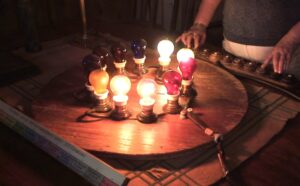Scriabin, Prelude for the Left Hand, Op. 9, No. 1
My undergraduate composition professor used to talk about seeing colors associated with specific musical keys. For example, he said F major was green and E-flat was bright orange. He talked about it as though the colors were actually visible, although he may merely have made a strong mental association. I can’t say, and I have never experienced anything like that.
 It’s called synesthesia, where the stimulation of one sense (e.g. hearing) triggers an involuntary experience of another sense (e.g. sight). My composition teacher wasn’t alone in this. The Russian composer Alexander Scriabin (1872-1915) saw colors in music. And one of Scriabin’s greatest champions, Sergei Rachmaninov, recounts a conversation in which Rimsky-Korsakov joined Scriabin in making the same claim.
It’s called synesthesia, where the stimulation of one sense (e.g. hearing) triggers an involuntary experience of another sense (e.g. sight). My composition teacher wasn’t alone in this. The Russian composer Alexander Scriabin (1872-1915) saw colors in music. And one of Scriabin’s greatest champions, Sergei Rachmaninov, recounts a conversation in which Rimsky-Korsakov joined Scriabin in making the same claim.
Scriabin pursued the issue, creating a color wheel of electronic lights that would accompany his music. His wife would work the lights while he played. It was perhaps one of the earliest light shows. He had plans to exploit this kind of multimedia event on a grand scale but did not live to achieve it. You can see his colored light contraption if you visit his house (now a museum) in Moscow. Professor Carol and I stopped by to do just that a couple years ago.
 You might be most likely to encounter Scriabin’s large-scale orchestral works. His popular named works, The Poem of Ecstasy and Prometheus: Poem of Fire, are actually two of his five symphonies. But he composed primarily music for solo piano. The recording below is an early work. I chose it partly for its simplicity (a virtue in music that is often undervalued) and also because it is written for left hand alone. That’s a topic I want to explore in more detail in future posts.
You might be most likely to encounter Scriabin’s large-scale orchestral works. His popular named works, The Poem of Ecstasy and Prometheus: Poem of Fire, are actually two of his five symphonies. But he composed primarily music for solo piano. The recording below is an early work. I chose it partly for its simplicity (a virtue in music that is often undervalued) and also because it is written for left hand alone. That’s a topic I want to explore in more detail in future posts.



